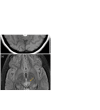Epstein-Barr virus encephalitis presenting as cerebellar hemorrhage
- PMID: 26475484
- PMCID: PMC4757131
- DOI: 10.1177/1971400915609349
Epstein-Barr virus encephalitis presenting as cerebellar hemorrhage
Abstract
Epstein-Barr virus (EBV) belongs to the human herpesvirus family and is ubiquitously found in the adult human population. The most common clinical manifestation of EBV is the syndrome of infectious mononucleosis. Central nervous system involvement by EBV is rare, with very few cases of EBV encephalitis reported in the literature. The majority of these cases report cerebral cortical changes on magnetic resonance imaging. We present a rare case of EBV encephalitis in a young patient with meningitis-like symptoms and cerebellar hemorrhage on magnetic resonance imaging.
Keywords: Encephalitis; Epstein–Barr virus; magnetic resonance imaging.
© The Author(s) 2015.
Figures

References
-
- Kalita J, Maurya PK, Kumar B, et al. Epstein Barr virus encephalitis: clinical diversity and radiological similarity. Neurol India 2011; 59(4): 605–607. - PubMed
-
- Ozbek O, Osman K, Paksoy Y, et al. Epstein–Barr virus encephalitis: findings of MRI, MRS, diffusion and perfusion. Turkish J Pediatr 2011; 53: 680–683. - PubMed
-
- Demey HE, Martin J, Leus R, et al. Coma as a presenting sign of Epstein–Barr encephalitis. Arch Intern Med 1988; 148(6): 1459–1461. - PubMed
-
- Johnson RT. The pathogenesis of acute viral encephalitis and postinfectious encephalomyelitis. J Infect Dis 1987; 155(3): 359–364. - PubMed
Publication types
MeSH terms
LinkOut - more resources
Full Text Sources
Other Literature Sources
Medical

